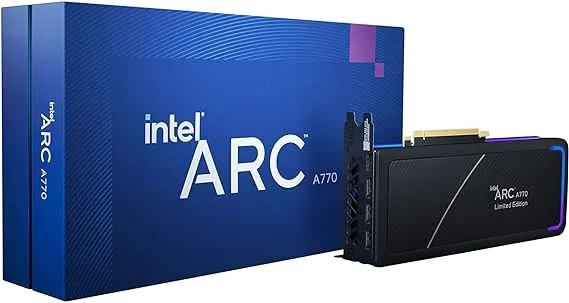
Intel Arc A770 GPU: Revolutionizing Generative AI with Affordable, Powerful Performance and Olive-Optimized Drivers - A Comparative Analysis with Nvidia and AMD in Gaming and AI Applications

The Intel Arc A770 GPU represents a significant stride in the realm of generative AI. Priced below $300, the A770, particularly its 16GB variant, stands out as an affordable yet powerful option for users interested in generative AI applications like Stable Diffusion. Unlike its performance in gaming, which is still evolving to match the prowess of competitors like the Nvidia RTX 40 and AMD RX 7000 series, the Arc A770 shines in the generative AI domain. Intel's strategic focus on this area suggests a keen interest in leveraging their GPU architecture to empower AI-driven applications.
The relevance of the Intel Arc A770 extends beyond mere affordability. Its integration into the rapidly expanding field of generative AI marks a pivotal shift. Generative AI models, once the domain of high-end, expensive hardware, are becoming increasingly accessible to a broader user base. This democratization of AI technology, driven in part by GPUs like the Intel Arc A770, is reshaping the landscape of creative and technological endeavors.
Performance Enhancements with Olive-Optimized Drivers
The recent collaboration between Intel and Microsoft marks a watershed moment in the evolution of the Intel Arc A770 GPU. Central to this advancement is the introduction of Olive-optimized drivers, a leap forward that has significantly amplified the GPU's capabilities in generative AI applications, particularly Stable Diffusion.
Intel's integration of Olive, Microsoft's cutting-edge tool for model optimization, into its driver software has yielded remarkable results. The most striking improvement is seen in Stable Diffusion 1.5, where the A770 GPU now exhibits a 2.7x performance increase compared to the original ONNX runtime for DirectML. This enhancement is not just a numeric uptick; it represents a substantial leap forward in the GPU's efficiency and capability in handling complex AI tasks.
The synergy between Intel's hardware and Microsoft's Olive toolchain is a game-changer. Olive's ability to harness AI and machine learning models, optimizing them for specific hardware configurations, plays a critical role in this enhanced performance. This optimization process, while theoretically feasible without Olive, becomes significantly more streamlined and effective with it. Intel Arc Alchemist GPUs, equipped with Xe Matrix Extensions (XMX) cores - analogous to Nvidia's Tensor cores - are specifically designed to accelerate AI workloads. The Olive-optimized drivers unlock the full potential of these cores, a step that previous drivers had not fully achieved.
This performance enhancement extends beyond Stable Diffusion 1.5. Intel and Microsoft are actively working to optimize drivers for newer AI models, including Stable Diffusion XL and Meta's Llama2. This forward-looking approach signifies not just a one-time improvement, but a sustained commitment to advancing the capabilities of Intel Arc GPUs in the rapidly evolving field of generative AI.
The implications of this collaboration and the resulting performance enhancements are significant. For users, particularly those with an interest in AI applications, the Olive-optimized drivers offer a more powerful and efficient tool at a fraction of the cost of more high-end GPUs. For the broader AI and tech community, this represents a step towards more accessible and potent AI computing, opening new avenues for innovation and creative exploration.
The enhanced performance of the Intel Arc A770 GPU, driven by Olive-optimized drivers, is a testament to the fruitful collaboration between Intel and Microsoft. It underscores the potential of targeted software optimization in unlocking hardware capabilities, setting a new benchmark in the performance of AI-driven applications like Stable Diffusion.
Comparative Analysis with Other GPUs
The performance of Intel's Arc Alchemist GPU, specifically the A770 model, marks an intriguing point of comparison with its rivals, Nvidia's RTX 40 series and AMD's RX 7000 series. While the gaming arena has long been dominated by these established players, the landscape of generative AI presents a different narrative.
In Gaming Performance:
Intel's Arc Alchemist series, particularly in gaming, has yet to reach the heights achieved by Nvidia and AMD. The RTX 40 and RX 7000 series GPUs have set high benchmarks in gaming performance, offering advanced features like ray tracing and AI-driven upscaling technologies. Intel, though making strides with the A770 in gaming, still faces challenges in optimizing performance and compatibility across a wide range of game titles.
In Generative AI Applications:
The scenario shifts when we turn to generative AI applications. Here, the Intel Arc A770 GPU demonstrates a significant competitive edge, especially with the recent Olive-optimized driver updates. The 2.7x performance boost in Stable Diffusion is a clear indicator of Intel's potential in this niche.
Technological Comparison:
- Intel's Xe Matrix Extensions (XMX) Cores: Intel's GPUs are equipped with XMX cores, designed to accelerate AI workloads. These cores are pivotal in generative AI applications, where they efficiently process AI algorithms, as seen in the performance improvements with Stable Diffusion. The recent enhancements suggest that Intel's hardware is now better utilized, unlocking capabilities that were previously underexploited.
- Nvidia's Tensor Cores: Nvidia's RTX series, renowned for its Tensor cores, is a powerhouse in both gaming and AI applications. These cores are highly efficient at AI-driven tasks, including deep learning and AI-enhanced graphics. Nvidia has also leveraged its software optimization, similar to Intel's approach with Olive, to enhance performance in AI applications.
- AMD's Approach: AMD, while lacking dedicated AI hardware like Nvidia's Tensor cores, has been making notable improvements in AI workloads with its RDNA 3 architecture. The RX 7000 series, although more oriented towards gaming, shows promise in AI applications, potentially benefiting from software optimizations similar to Intel's approach.
The comparative analysis reveals a nuanced landscape. Intel's Arc A770, with its recent advancements, is emerging as a strong contender in generative AI, challenging Nvidia's dominance and offering an alternative to AMD's GPUs. In gaming, however, Intel is still catching up to its competitors. This dynamic points towards a diverse GPU market, where each player has distinct strengths, catering to different segments of consumers and applications. Intel's progress in AI applications, particularly with Olive-optimized drivers, underscores the importance of software optimization in harnessing the full potential of GPU hardware.
Future Outlook and User Implications
As we look towards the future of Intel Arc GPUs, particularly in the realm of generative AI, the horizon appears promising. The advancements in the Intel Arc A770 GPU, primarily through the Olive-optimized drivers, indicate a growing potential for these GPUs to become a mainstay in the generative AI landscape. This evolution has broad implications, not just for the technology itself but also for its users, ranging from AI enthusiasts to content creators.
For Users Seeking Cost-Effective AI Solutions:
The Intel Arc A770, especially with its recent performance enhancements, stands out as a cost-effective solution for generative AI applications. Its affordability, coupled with the significant performance gains in Stable Diffusion and other AI models, makes it an attractive option for users who need efficient AI processing without the steep price tag of higher-end GPUs. This democratization of AI technology can spur a wave of innovation and creativity among a wider user base, breaking the barriers of entry that often come with high-end computing requirements.
Ease of Use and Accessibility:
Intel has placed considerable emphasis on user accessibility and ease of use. The Intel Graphics team provides comprehensive tutorials and guides, making it simpler for users to set up and start generating AI images, even for those new to AI or GPU technologies. This focus on user-friendly resources is crucial in encouraging wider adoption and experimentation with AI tools and applications.
Implications for Content Creators and AI Enthusiasts:
For content creators, the enhanced capabilities of the Intel Arc A770 open new avenues for creative expression. The ability to efficiently run powerful generative AI models like Stable Diffusion means creators can experiment with AI-driven art, design, and multimedia projects, expanding the boundaries of their creative portfolios. Similarly, AI enthusiasts and researchers can leverage the enhanced performance of the Arc A770 for various AI tasks, from image generation to deep learning experiments, making the GPU a valuable tool in their technological arsenal.
Looking Ahead:
The trajectory of Intel Arc GPUs in the generative AI space is one to watch closely. With ongoing developments and future optimizations, particularly in driver software, Intel is poised to further solidify its presence in this field. As the technology evolves, so too will the opportunities and applications it enables, heralding an exciting era for AI-driven creativity and innovation.









